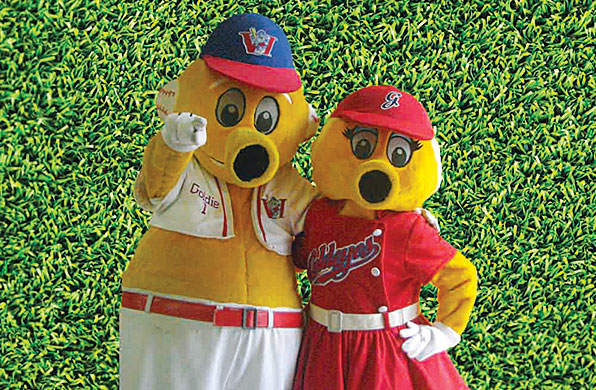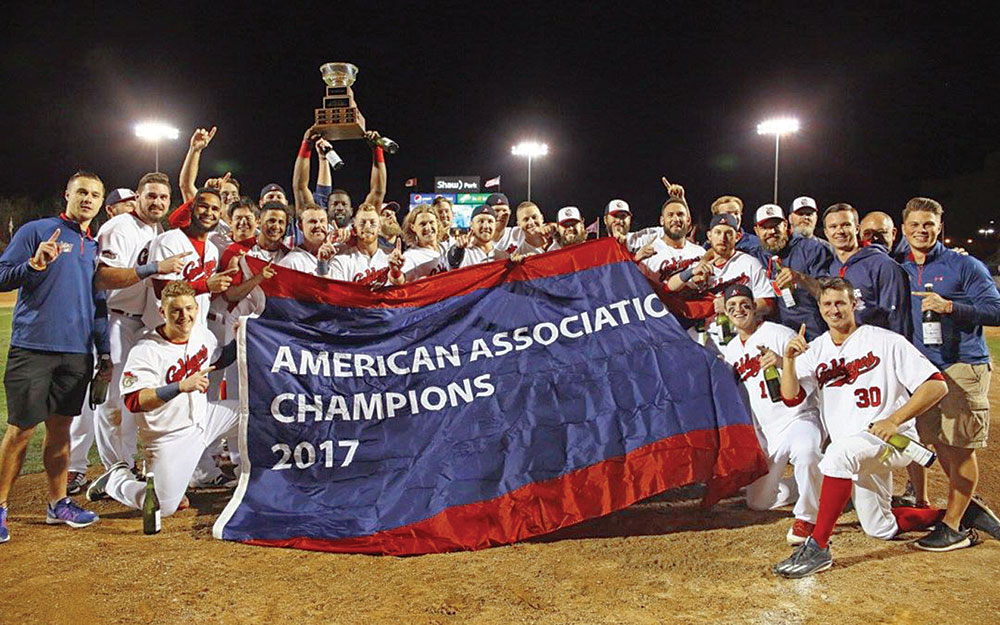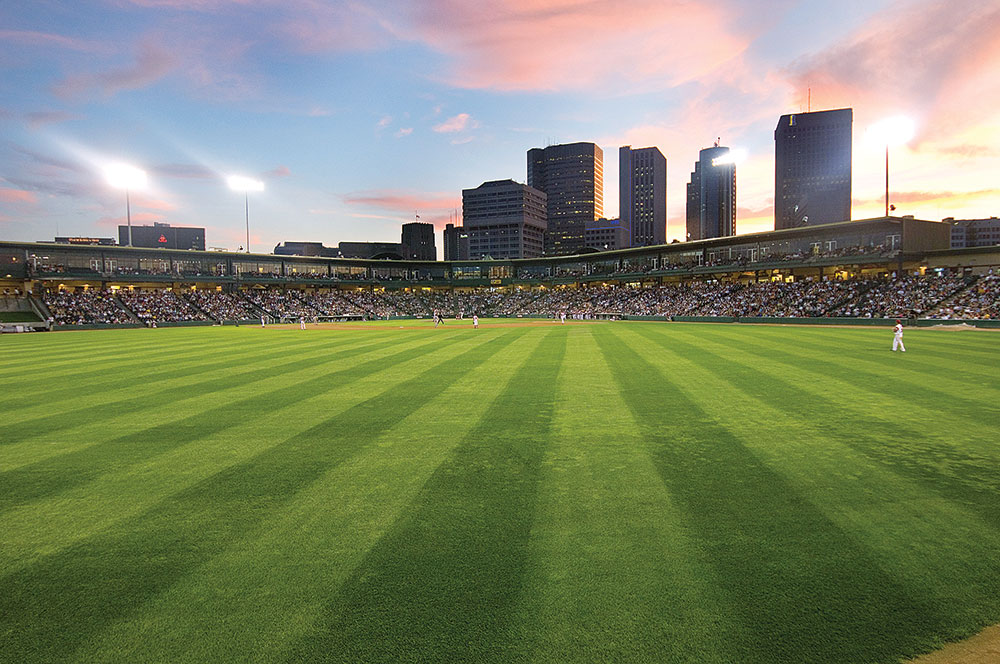By Bill Burfoot
It’s been a quarter-century since the first pitch was thrown by a Winnipeg Goldeye on June 7, 1994, and what a 25 years it’s been.

It doesn’t seem that long ago that 24-year-old Tim Cain threw the first pitch at the Goldeyes home-opener in the old Winnipeg Stadium in front of close to 15,000 fans, guiding the club to their first of 43 wins that season, a 9-1 triumph over the Duluth Superior Dukes. Winnipeg went on to capture the Northern League title that season, thus setting the foundation for professional baseball in Winnipeg for years to come.
This wasn’t Winnipeg’s first foray into the world of professional baseball. In 1954, the Winnipeg Goldeyes joined the original Northern League, playing from 1954 until 1964. It was a successful 10 years for the club, capturing the league title three times (1957, 1959, and 1960) as the minor league affiliate of the St. Louis Cardinals. The Goldeyes returned to the Northern League for one season in 1969, as an affiliate of the expansion Kansas City Royals but did not return in 1970, and the entire league shut down after the 1971 season.
How it began
Fast-forward to 1993, Miles Wolff, a long-time owner of minor league teams and one of independent baseball’s pioneers, re-established the Northern League. The new league consisted of teams operating from outside the sphere of organized baseball and were located in the upper Midwest region of the United States and into Canada, including the Duluth-Superior Dukes (Duluth, Minnesota), Rochester Aces (Rochester, Minnesota), St. Paul Saints (St. Paul, Minnesota), Sioux City Explorers (Sioux City, Iowa), Sioux Falls, Canaries (Sioux Falls, South Dakota) and Thunder Bay Whiskey Jacks (Thunder Bay, Ontario).
For Winnipeg, the dream of having professional baseball return to the city had begun a few years prior, when Sam Katz, a life-long baseball fan and successful concert promoter in Winnipeg, helped bring an exhibition game between the Toronto Blue Jays and Canada’s National Team in 1987. After a few years of failed attempts to relocate teams from Triple-A baseball to Winnipeg, Katz and Wolff began discussions about Winnipeg joining the newly formed independent league. In 1994, the dream became reality as the Rochester Aces relocated to Winnipeg, and the rest, as they say, is history.
Upon their rebirth in 1994, the modern-day Winnipeg Goldeyes made an immediate impact on the city by capturing the Northern League championship in their first year. Winnipeg defeated the Sioux City Explorers three games to one in the Northern League Championship Series, and maybe more impressively, drew more than 212,000 fans (5,314 fans per game). The championship marked the first of 10 consecutive playoff appearances (including seven berths in the Northern League Championship Series) for the Goldeyes, a feat still unmatched by any Northern League or American Association team today.
After their inaugural championship season, it would be 18 years before another title would be won. Despite not winning championships, the Goldeyes were continuously near the top of the league standings, and continued to be successful both on and off the field.
After spending five years playing out of the Winnipeg Stadium, known for its bad sightlines, hard turf, and short outfield, Katz and company built what is now known as Shaw Park (formally CanWest Global Park). The beautiful 6,140 seat stadium opened its doors in downtown Winnipeg May 24, 1999 and was a big upgrade from the early days of the franchise. Nearly 300,000 fans packed the new stadium during the club’s first season in the new park, averaging 6,048 fans per game as the Goldeyes reached their fourth Northern League Championship Series. In 2003, Shaw Park went through some upgrades, adding additional 1,200 seats. With the success of the club on the field, and the beautiful baseball park in downtown Winnipeg, it’s no surprise the Goldeyes have continuously been one of the top drawing teams in independent baseball, setting numerous league and attendance records.
2011 marked a major change as the Goldeyes joined the independent American Association along with Fargo-Moorhead, Gary SouthShore, and Kansas City. The league, which formed in 2006, was now a 14-team circuit with only four teams qualifying for the postseason. Despite a new league and many more opponents fighting for position, the Goldeyes won a franchise-best 60 games, and used a dominant finish (17-8) to put away the American Association North Division. In one of the most exciting playoff series in team history, the Goldeyes fell in heartbreaking fashion to the St. Paul Saints in the ninth inning of the decisive fifth game at Midway Stadium. Winnipeg fans would once again fill Shaw Park, averaging 5,740 fans per game, which was not only best in the American Association, but in all of independent baseball, helping Winnipeg bring home its first American Association Organization of the Year award.

Championships in dramatic fashion
If you’re going to wait 18 years before your next championship, you may as well do it in dramatic fashion right? Well that’s exactly what the Goldeyes did in 2012. The 2012 team may not have been the most talented group in Goldeyes history, but the grit they showed to hoist the trophy at the end of the year was remarkable. Qualifying for a wild-card berth with just three games left in the regular season, the Fish went on a tear in the playoffs, posting a 6-0 record against Fargo-Moorhead and Wichita to bring the title home. They were the first, and to this day, still the only American Association team to accomplish this feat.
The Goldeyes would miss the post-season in two of the next three seasons, but in 2016 they found their way back to the top, winning the American Association Championship for the second time in five years, and again it was in dramatic fashion. The Goldeyes qualified for the playoffs on the final day of the regular season when left-handed pitcher Kevin McGovern tossed a complete game two-hitter over the RedHawks that clinched the American Association wild card. In the Division Series, the Goldeyes came back from a 2-1 series deficit against the St. Paul Saints, winning Games Four and Five on the road, sending the Goldeyes into their ninth league final in team history against the Wichita Wingnuts. Winnipeg would once again have to battle back after falling behind 2-1 in the series, but after a big win in Game Four, the American Associations all-time leader in home runs, and perennial fan-favorite Reggie Abercrombie hit two home runs in Game Five, setting a franchise playoff single-game record with seven RBI in the deciding game, propelling the Goldeyes to the 2016 title.
The organization enjoyed that championship so much, they decided to win the championship again in 2017. In what has become the norm for the Goldeyes, it would be again be in dramatic fashion. After a season which saw them win a league-best 62 games and clinch the North Division title, Winnipeg would get by a stubborn Lincoln Saltdogs club before going head-to-head with the Wichita Wingnuts in the championship final for the second-straight year and third time in the last six. Just as they did in the 2016 series, Wichita grabbed a 2-1 lead, and once again, the Goldeyes would have to win the final two games to win. Game Four will go down as one of the most memorable and talked-about games in American Association history. Wichita had a 3-2 lead in the bottom of the ninth and looked to win the championship after Casey Turgeon hit a groundball that was thrown to first for the final out. Wichita players stormed the field, their gloves being tossed in the air, but a balk had been charged to Wingnuts pitcher Ryan Kussmaul prior to the pitch. Turgeon was given a second chance and made the most of the opportunity, driving a double to left-centre that scored Wes Darvill to tie the game at three. It stayed that way until the bottom of the 17th inning when a David Rohm double scored Turgeon, giving Winnipeg a 4-3 win. The game took five hours and 59 minutes to play, setting a record for the longest game in league history, and set up a deciding fifth and final game in Wichita. Game Five was never in doubt, as the Goldeyes rattled off 18 runs en route to their third championship in six seasons, by a final score of 18-2.
The 2018 season may not have produced a third consecutive championship, but it’s been quite a run for the organization since that first game in June, 1994. They’re the only professional sports team in Winnipeg to have won a championship in the past 25 years, and have been one of the most consistent and successfully run franchises in independent baseball history. Here’s to the next 25 years!


Hi there, I wish for to subscribe for this webpage to get most recent updates, therefore where can i do it please help.
Stop by my web site – constantcontact.com